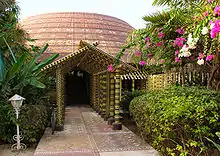Impluvium (house)
An impluvium is a type of dwelling typical of the Jola in the Casamance region of Senegal. It is a circular mud building, built with a ring of rooms around a walkway that circumscribes a central water trench, fed by an opening that allows water into the building. Impluvia remain cool in very hot weather as the water evaporates.

There is a particularly fine example that serves as a hotel in Enampore. Impluvial architecture is also used by the Igbo, Yoruba and Edo of southern Nigeria, in which they consist of small courtyards cornered with large pots to collect rain water. Edo and Yoruba houses usually consist of several impluvia and courts. The amount and size of these courts depend on the social and economic status of the individual. Royal palaces in Yorubaland and the Kingdom of Benin possessed hundreds of impluvia sometimes floored with elaborate pavements made of potsherds and quartz pebbles arranged in decorative patterns.
History
The structures came into existence due to the area's climate and environment as a rain forest. The region receives a lot of precipitation during the rainy season, then loses the water due to the soil's polarity, so the people came up with the impluvial as a way to store the water for the dry season.